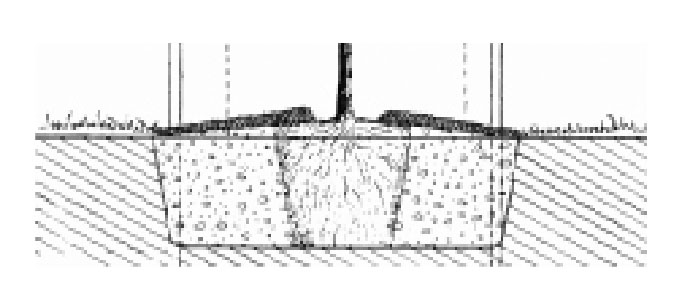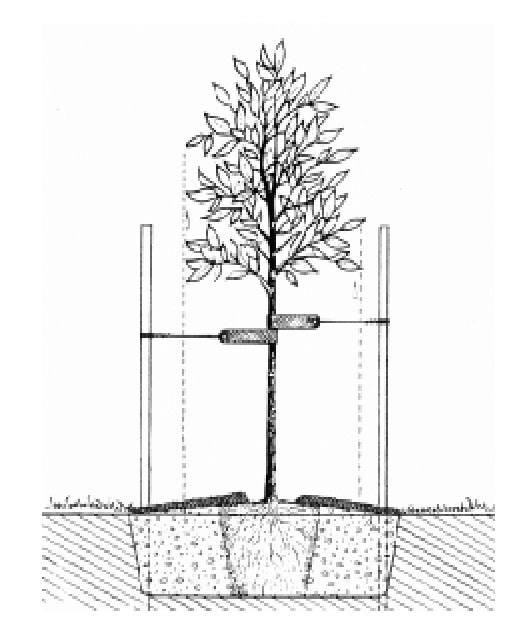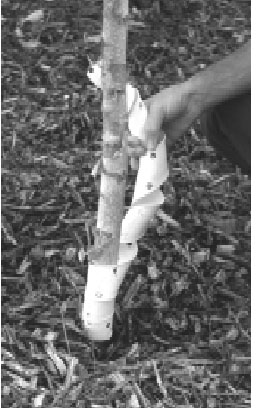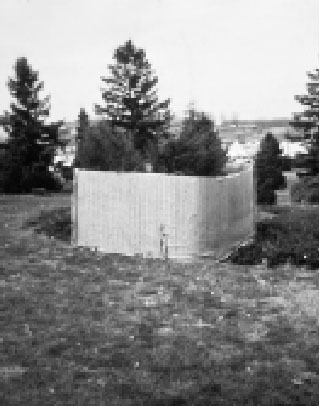Planting Trees and Shrubs
Trees and shrubs normally increase the value of real estate. A combination of trees and shrubs can lower energy consumption as well. Trees have the greatest impact on the living environment, thus it is best to select adapted, pest-free trees and plant them properly.
Planting begins with the selection of species adapted to the site and climate. For
example, pin oak and sweetgum will develop chlorosis in alkaline soils. This is due
to their inability to take up/utilize certain micronutrients when growing in near
neutral to alkaline soils. Yet sweetgum will tolerate poorly drained, clay soils that
would kill an oak. While an oak has some drought tolerance, sweetgum has none. The
time to decide on the species is long before you go to the nursery to select the tree
or shrub. For more information, contact your county Extension educator, local nursery
personnel, park or arboretum manager, or study areas of your city that have mature
trees.
To ensure successful tree establishment, the following planting techniques and methods
should be used.
Plant Types
Today several types of plant production techniques are used to grow plants offering the consumer several options. Each has advantages and disadvantages, which are discussed below and will dictate the manner in which they are handled and planted. No matter which plant type is chosen, it is always important to choose a quality grown plant.
Bare-root or packaged plants should be dormant (not showing new growth). The bare-root
plant is often prepackaged in a colorful bag. Open the bag immediately and dampen
the roots until planting. At planting remove all bags, strings, or wires (Figure 1a)
Balled and burlapped (B&B) plants are dug with roots and soil intact and covered with
burlap (Figure 1b). Still, 90 percent or more of the roots have been lost. Evergreens
and large trees are often sold B&B. These plants will be more expensive than bare-root
plants because of labor costs both in digging and handling as well as increased shipping
expenses. With B&B plants, burlap should be tight around root balls, and the ball
should move with the plant as it is tilted.
Container growing is a common method of producing high quality plants with costs similar
to B&B. Less loss from transplanting container-grown plants occurs since few to no
roots are lost if the plant was grown in the container. Roots should not be growing
out of container drain holes nor circling around the inside of the pot (Figure 1c).
Potted plants are bare-root plants that have been grown in the field, but they are
put in a soil mix in papier mâché pots for ease of handling. This does not provide
the same quality plant as a plant grown in a container. Roses, for example, are commonly
marketed this way.
Regardless of container material, papier mâché, ridged plastic, polyethylene, etc., remove it at the time of planting.

Figure 1a. “Bare-Root” plants.
Figure 1b. “B&B” plants.
Figure 1c. “Container” or "Potted" plants.
Planting Times
Planting time varies from fall to spring by plant type and method of growing. Research suggests that early fall planting is best for container-grown and B&B shade and ornamental trees and pines, but spring is best for planting bare-root plants and broadleaf evergreens, such as holly and Southern magnolia. Plants planted in the fall have more time for the root system to become established before the onset of summer heat. Plants installed during the growing season are susceptible to high transpiration rates leading to drying of plant tissues. However, many containerized plants can be planted any time if handled properly.
Most bare-root or packaged plants should be planted between mid-February and mid-April or up to the end of the frost period. Other than seedling-sized evergreens, only deciduous plants can be transplanted with bare roots, and then only when dormant or leafless.
Handling Trees and Shrubs before Planting
Avoiding unnecessary damage and stress to plants prior to planting will ensure better success. Keep the root ball moist. Handle a plant by the container, not by the trunk or stems. Roots of mail order plants (when bare-root) should be placed in water immediately upon receipt or lined out in the flower bed or garden by digging a shallow trench, placing roots in the trench and covering with soil or other material such as straw, until permanent planting can be done.
It is critical to keep the roots of all plants damp or moist until the moment of planting. Be careful when planting not to break the ball of roots. Breaking the root ball is often fatal to young trees and shrubs, especially pines. Strings used to secure the burlap to the base of the tree and the burlap itself should be removed from the root ball after placing the root ball in the hole. Be especially careful to remove strings from around the trunk. When planting potted plants, tear the sides off the pot and handle carefully.
Planting Sizes
The optimum tree planting size for most homeowners that ensures transplanting success and is more cost effective is a five-gallon container. Five-gallon-sized container-grown shrubs or 24- to 30-inch bare-root shrubs are preferable over smaller seedlings. However, this is merely a rule of thumb as success can be realized with various sized plants when attention to detail is employed.
Planting Methods and Techniques
Preparing the Hole
Preparing the planting area properly before planting is very important. Beyond climatic adaptation, soil drainage or percolation is the greatest limitation to successful transplants in urban soils. A poorly drained clay soil is either too wet or too dry for all but the most durable trees and shrubs.
Most urban soils are abused during construction processes. Loamy soils often have
been removed or compacted during construction. The foundation of a building is also
a convenient burial ground for construction debris! Probe the bed 12 to 18 inches
deep for building debris and remove it. Soil drainage, compaction, and building debris
problems must be resolved before planting is done. Do not apply amendments to the
backfill, and do not line crushed stone or gravel on the bottom of the hole. Neither
of these methods improves drainage.
The easiest way to help a young tree or shrub survive is to dig the planting hole much wider than is normally done. In fact, it is much better to dig an entire bed area for shrubs, rather than individual holes. When preparing individual holes, dig the planting hole two to three times the diameter of the tree or shrub’s root ball and no deeper than the root ball itself. Since most Oklahoma soils are clay, plant trees and shrubs one to two inches above grade. Planting above grade leaves roots susceptible to desiccation; therefore, it’s imperative to immediately mulch above ground plantings. Plant trees and shrubs at original grade in sandy soils. When backfilling, be sure to bring soil up to the top edge of the root ball so that roots are not left exposed. The sizes of the holes discussed in this fact sheet are considered minimum standards.
Planting Bare Root Trees and Shrubs
Trees and shrubs should be planted at the same depth at which they were growing in the container or field nursery. There is a texture and color change between the trunk or stem and the roots. The base of the plant should not be covered with more than about one inch of soil. Planting too deep is a major cause of plant failure, especially in poorly drained clay soil.
Holes for bare-root plants should be dug large enough to accommodate the roots without crowding or twisting. The hole should be no deeper than the original root depth and at least twice the spread of roots. Broken and badly damaged roots should be removed. A mound or cone may be made in the center of the hole to accommodate the spread of roots and allow the tree or shrub to rest at the proper depth while backfilling the hole (Figure 2).
 Figure 2. Planting bare root plants. Make hole two to three times wider than the root system.
A mound may be needed to rest the plant on. Add soil, press, but do not stomp to firm
the soil around the roots. Fill the hole with water and let it drain. Fill the hole
with soil to the planting line on trunk and water again. Do not pack the soil again.
Figure 2. Planting bare root plants. Make hole two to three times wider than the root system.
A mound may be needed to rest the plant on. Add soil, press, but do not stomp to firm
the soil around the roots. Fill the hole with water and let it drain. Fill the hole
with soil to the planting line on trunk and water again. Do not pack the soil again.
Work the soil under and around the roots to remove air pockets. Firm the soil while filling until the hole is three-quarters full, and then fill the hole with water. This will settle soil around the roots. After the water has soaked in, finish filling the hole with soil and water again. If the soil around the plant settles, bring it back up to grade with additional soil.
Thoroughly water B&B, container, and bare-root plants before planting. A dry root ball may not get thoroughly wet at planting. Never leave roots exposed to air. Very fine root hairs, which are not visible to the naked eye, are responsible for moisture and nutrient uptake and are killed when exposed to dry air for even a very short period. Keep the roots damp and covered while preparing the planting hole to protect the fine root hairs.
Balled and Burlapped, Container-Grown, and Potted Plants
B&B, container, and potted plants should be planted in a similar manner as bare-root plants, except eliminate the mound (Figure 3). The hole should be no deeper than the root ball itself and should be at least two times wider than the root ball. Remember, when planting in clay or poorly drained soils, dig the hole less deep so that the top of the root ball is one to two inches above grade. When backfilling, be sure to bring soil up to the top edge of the root ball so that roots are not left exposed.

Figure 3. B&B and various container plants.
Backfilling the Planting Hole
Studies have shown that in most cases it is not beneficial to apply amendments to the backfill. In fact, it often delays establishment of the tree or shrub, and may result in further complications such as root rot. If soil amendments such as leaf mold or peat moss are needed to improve soil conditions, it is better to prepare an entire bed or area rather than individual holes. Do not put crushed stone or gravel in the bottom of the hole! Gravel placed in the bottom of the whole will hinder water movement, thus creating soggy conditions in the bottom of the hole. The best backfill around a new tree or shrub is native soil. Fortunately, many ornamental trees and shrubs grow well in a variety of soils.
Fertilizing
A new tree or shrub has a very limited capacity for utilizing fertilizer until it becomes established, thus fertilization often is not recommended at the time of planting. Excessive fertilizer in the root zone can be damaging, so do not add fertilize to the backfill or dump it into the bottom of the hole. If fertilizer is used at planting or in the first growing season, consider a controlled-release or diluted liquid fertilizer on the soil surface.
Ideally, young trees and shrubs may be fertilized from March through July. For more information on fertilizing, refer to OSU Extension Fact Sheet HLA-6412, “Fertilizing Shade and Ornamental Trees and Shrubs.”
Watering
Newly planted trees and shrubs should be watered well at the time of planting. Natural rainfall is usually not adequate to provide the moisture needs of recently installed landscape plants.
Generally, young plantings need an equivalent of one inch or more of rain per week. Newly planted trees and shrubs may need to be watered two or three times a week in extremely hot, dry, windy weather because their root systems cannot take up the amount of water needed to replenish the water lost through leaves. Watch for signs of wilting as one indicator that the plant needs water. But also be aware that some plants in chronically wet sites may also wilt. Feeling or probing in the soil around the root ball is also another way to monitor soil moisture. Apply water slowly at the base of newly installed plants. This is especially important for container grown plants as their soilless mixes can dry or shed water while the bed or surrounding soil remains damp. If you have several young trees and shrubs, a trickle irrigation system would be wise.
Be cautious not to overwater or the amount of oxygen in the soil will be lowered to a level that will damage roots. Make certain the timing and patterns of lawn watering systems are not overlapping into plant beds and too much water is being applied.
Mulching
Keep a four to six foot, grass-free circle around young trees and shrubs the first
two to three years. Benefits of mulching to create a weed and turf-free area include
reduced plant competition for water and nutrients and even soil temperature and moisture.
Keep the grass-free circle filled with two to four inches of organic mulch, such as
leaf mold, compost, bark, grass clippings, or straw. DO NOT use plastic under the
mulch to prevent weeds. Roots are drawn to the surface and may be damaged by summer
heat and winter cold. Consult with nursery or garden personnel for landscape fabrics
that “breathe” allowing for gaseous exchange. Do not use rock mulches that transfer
heat directly to the roots or limestone chat that releases calcium into the soil.
Do not mound mulch up against the trunk of trees or shrubs. Keep the mulch two to
four inches away from the trunk; this is particularly helpful in preventing rodent
damage during winter months. Excessive mulch against a trunk may also result in an
environment favorable to disease and insect attack. For more information on mulching,
refer to OSU Extension Fact Sheet HLA-6005, “Mulching Garden Soils.”
Pruning the New Tree
Avoid overpruning new trees. Do not top or cut back shade trees at planting. It does not benefit the plant and often causes an undesirable fork in the main trunk. Do not prune top growth when planting in an attempt to compensate for root loss for either trees or shrubs. Recent research has shown this practice to be of no value and perhaps even counterproductive. Excessive pruning at planting reduces leaf area, which decreases the amount of plant energy generated that is needed to create a healthy root system. When transplanting woody plants, the only necessary pruning is the removal of broken or damaged branches.
Overpruning may also result in sunscald and inhibit tree growth. Leave lower limbs intact if possible for the first few seasons. Small lower limbs will provide shade to thin-barked species thus protecting them from sunscald injury. Remove injured or diseased branches only.
Pecan trees are the exception to this rule. Their survival is greatly increased if the trunk or branching is cut back to 50 percent of its total length at planting. If young fruit trees are to be planted to double as yard trees, you may want to cut them back to stimulate branching. However, avoid low branching as harvest comes but once a year; whereas mowing and other routine activities around and under the tree may be nearly year round. Refer to OSU Extension Fact Sheet HLA-6409 for detailed information regarding tree pruning.
Staking
Stake young trees sparingly and briefly when possible. In fact, prolonged staking
can have detrimental effects on the development of the tree. Too often, staking materials
end up injuring or girdling a tree. Stake when top-heavy or planted in windswept areas.
If a tree needs to be staked, use no more stakes than absolutely necessary. Leave
the tree as much freedom to move as possible. As the tree flexes or “exercises,” it
develops greater strength faster (trunk broadens faster when sway is allowed). Do
not make the trunk rigid. Also, do not run wires or anything else around the trunk.
Instead, use material that is broad, smooth and somewhat elastic. Stakes should be
placed into solid ground far enough away from the tree so that the tree does not rub
against it in the wind. Do not drive stakes into the root ball of the tree or damage
to roots may occur (Figure 4).

Figure 4. This method in no way damages the tree trunk, unless the webbing is too abrasive or if the wind bangs the tree against the stake.
Use straps of chair webbing made of plastic or cotton fiber available commercially that already have grommets inserted through the ends. Then, put the wire through the grommet and tie it to a stake. This soft webbing material is less abrasive than the hose and wire method in common use.
Triple staking provides more protection against strong wind. Support stakes and guy wires generally should be removed after one growing season. If staking is left in place for more than two years, the tree’s ability to stand alone may be reduced, and the chances of girdling injury are increased.
Trunk Protective Materials
Young, thin-barked trees such as ash, birch, linden, maples and others often sunscald unless protected. The twigs that shade the trunk should be left, but cut back a few inches so they become denser. A twiggy trunk is preferable to tree wraps, but not all trees have enough twigs, nor is it always practical or aesthetically pleasing to leave lower limbs. Protective wraps are available and may provide protection by modifying temperatures for thin-barked trees. Plastic wraps may provide better protection than paper wraps against lawn mower, weed-eater, and rodent damage. If misused, however, damage may occur in the form of trunk girdling or constriction, insects, diseases, and excessive bark moisture.
Protective wraps may not be necessary at planting time. Use based on the type of protection needed. Normal application of tree trunk wraps is October to March for the first two growing seasons. Wraps should be removed each spring prior to spring growth. During spring growth the trunk expands and increases in size. Wraps too tightly wrapped or left on during this time may result in constriction to the trunk. Tree wraps should be applied loosely from base up to the first branch by overlapping for a shingle effect (Figure 5). Plastic wraps should fit loosely and include holes or slits for good air movement. Periodically inspect the wraps for trunk damage and insects.

Figure 5. Wrapping young trees.
Seedling trees and shrubs or young plants may need a shelter from weather extremes during either the winter or summer. Cheesecloth, burlap, or various other windbreaks can be used. Unfortunately, antidesiccants generally do not relieve plant stress in Oklahoma in winter or summer (Figure 6).

Figure 6. Protect young plants from wind and sun.
Summary
- Check soil drainage and correct problems found
- Use no amendments in the backfill soil
- Mulch with organic matter such as pine bark or straw
- Do not put plastic under mulch
- Keep a grass-free circle around young trees for two years
- Do not prune back the tops of trees except to remove narrow “V” forks in the main trunks
- Fertilize trees and shrubs on the soil surface only if necessary as determined by a soil test
- Stake only if necessary
Good trees, when properly planted, will reward the planter and the next generation with luxuriant growth, shade, and shelter.
David Hillock
Extension Consumer Horticulturist
Mike Schnelle
Extension Ornamental Horticulturist
